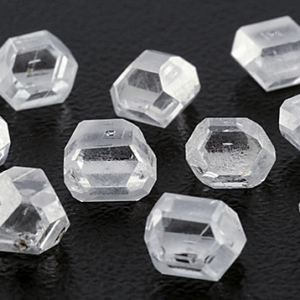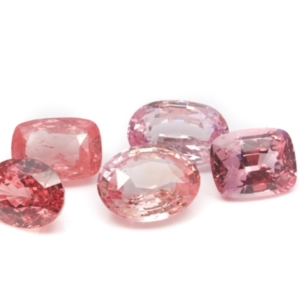Gemfields Emerald and Ruby Auctions

Figure 1. Fine emerald (>60 ct) and ruby (13 ct) crystals offered at the 2024 Gemfields auctions in Bangkok. Photos by Wim Vertriest.
In May and June 2024, ICIA was able to attend viewings of rough gemstones prior to Gemfields auctions in Bangkok. The first viewing offered emeralds from Gemfields’ Kagem mine in Zambia, and the second featured rubies from the MRM mine in Mozambique (figure 1). Both viewings were immediately followed by the tender, where bids were submitted online and the winners of each parcel were notified.
Many international buyers attended the auctions, with strong interest from Indian and Israeli companies in the emeralds, while Thai and Indian companies focused mostly on the rubies. Several firms from Europe, China, and other Asian nations also submitted bids on parcels.
Figure 2. Large emerald crystals from the Kagem mine in Zambia. The three crystals have a combined weight of 106 g, while the large single crystal weighs 479 g. In these stones, visible fractures and inclusions will determine how the pieces are processed into smaller preforms before going to polishing. Photos by Wim Vertriest.
During both auctions, production from recent months was offered in pre-graded parcels. These lots are created by experienced professionals who have often spent decades working with the respective gemstones. The first factor in sorting is the size of the stones. Larger stones usually hold higher value, so these are often in very high demand by companies that specialize in fine single stones. Several substantial emerald crystals were available, including one that weighed 479 g (figure 2).
Figure 3. Large parcel of smaller emeralds of very high clarity; the average size of the crystals is between 2.8 and 4 mm. Photo by Wim Vertriest.
Figure 4. Range of rubies produced by the MRM mine in Mozambique: pinkish red material (left, 3.5–5.0 ct) and darker, more “closed” red rubies (right, 2.5–3.5 ct). Photos by Wim Vertriest.
While these exceptional specimens stand out, the true power of skilled gemstone sorting is evident in the larger parcels. Emerald quality is determined by the richness of green color and the clarity (figure 3). When inspecting rubies, color is the most important factor, with different grades assigned based on the intensity of color, the orientation of color, and secondary color components (orangy or purplish). In the case of Mozambique rubies, the color ranges broadly from bright, intense pinkish red to a darker, more “closed” burgundy red (figure 4). Inclusions, especially dense silky bands, bring an extra dimension to ruby grading. This precise grading results in parcels that contain similar-looking finished gemstones in terms of color, size, or both. In some cases, fine gemstones of similar quality but different sizes are offered together because they would create a perfectly matched set (e.g., a larger stone suitable for a ring with two matching earrings and a necklace layout featuring smaller stones).
All products are offered untreated, with the exception of oiling. Oil is routinely used to inspect rough because it can minimize surface reflections and allow better observation of the clarity of the rough gems. While oil generally does not penetrate deep into fractures as it does during intentional fracture-filling treatment, rough buyers typically deep-clean the rough before starting the manufacturing process. All of these rubies are untreated. (Gemfields previously offered some treated parcels but discontinued this practice a few years ago.)
Rough emerald valuation is complex because of the abundant fractures that run through a crystal, and a single crystal will often result in many polished emeralds. This is especially true for the larger pieces of rough emerald. With rubies, a single piece of rough usually results in a single finished gem.
The seemingly unremarkable parcel shown in figure 3 attracted significant attention at the emerald auction. At first sight, this parcel might be overlooked due to the small size of the stones, with some as small as 0.5 g. But on closer examination, all of these stones were unusually clean and had a rich color; such emeralds are very rare and in high demand. This 500 g parcel could be turned into exceptional faceted emeralds.
At these high-stakes auctions, winning or losing a parcel can be determined by variations as small as 0.5% of the total price. While single stones of notable size gather the highest price per carat, the economic impact of larger parcels of smaller gems is often greater. These parcels require much more manufacturing time (and cost), and the profits gained from them are often needed to keep cutting workshops in operation. Missing out on a large parcel could result in the suspension of manufacturing operations, potentially leading to the loss of the valuable skilled labor required to optimize the rough-to-cut process.
During the event, buyers are allowed a specific time slot to inspect stones. This often involves an entire team of specialists, including heat treaters, preformers, and polishers. The final value of a stone will be determined by its color, shape, and size. Cutting, especially the preforming, is the most important aspect of this process. Experienced cutters assist the company owners by offering input on what can be done with a piece of rough. For example, the same crystal could yield a 4 ct pear shape or a 3.5 ct cushion. Making such decisions is crucial because the final price of the fashioned gem will be different. This difference must be reflected in the bid placed on the parcel. Considering that certain parcels consist of a few hundred stones, this is a painstaking exercise where minute details can tip the scales one way or another.
Another aspect of valuing the rough involves the impact of potential treatment. The extent of fracture filling can affect the value of an emerald and must be taken into account. The price premium for an untreated stone must be weighed against the value of a stone with a cleaner look from a certain degree of fracture filling or improvement in color due to heating during the manufacturing process. Many buyers are aware that certain grades of ruby will require treatment to improve the color (e.g., rubies with a strong purple tint). The final ruby color is an enormous value factor, which is why a heat treatment expert is often part of the decision-making team at the ruby auction. Striking the right balance between improved color and the price premium for an untreated stone becomes more complex with every auction.
During the May–June tenders, Gemfields offered high-quality rubies and medium- to high-quality rubies. The ruby sales totaled nearly US$69 million, with 97% of the offered goods finding a buyer. The emerald sale included only higher quality rough and totaled US$35 million, with 93% of the lots offered sold.


Leave a Reply
Want to join the discussion?Feel free to contribute!